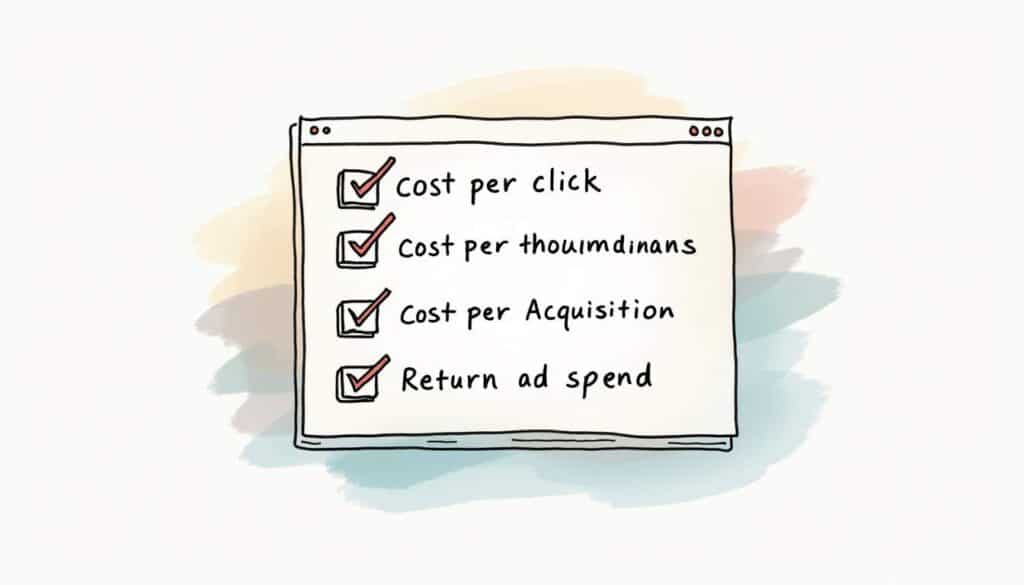Table of Contents
- Why Google Ads bidding strategy matters now
- Overview of the four main Google Ads bidding strategies
- Cost Per Click (CPC): traffic-focused and tactical
- Cost Per Thousand Impressions (CPM): the brand-awareness engine
- Cost Per Acquisition (CPA): conversion-focused and disciplined
- Target ROAS: align bids with revenue goals
- How to choose between CPC, CPM, CPA, and ROAS
- Measurement, attribution, and data hygiene
- Common pitfalls and how to avoid them
- Practical roadmap for picking and testing a strategy
- Final thoughts and quick checklist
Choosing the right bidding strategy in Google Ads can significantly impact the success of an online campaign. As we navigate 2025, with more automation, rising costs, and advanced algorithms, advertisers must understand when to utilize Cost Per Click (CPC), Cost Per Thousand Impressions (CPM), Cost Per Acquisition (CPA), and Return on Ad Spend (ROAS). This guide explores each model’s function, appropriate usage, and practical application with real-world examples and current benchmarks.
Why Google Ads bidding strategy matters now
Google Ads platforms are continuously enhancing their machine learning-driven bidding systems, making it insufficient to merely allocate a budget to a campaign. The right strategy aligns campaign goals with how Google charges and optimizes, influencing reach, costs, conversions, and profitability.
In 2025, with increased average costs and improved conversion rates, selecting the correct model is crucial. A poorly chosen bid strategy can squander budget, while a well-suited one can efficiently scale results.
Furthermore, the complexity of consumer behavior and the multitude of touchpoints necessitate dynamic bidding adjustments. Advertisers must not only choose the right bidding strategy but also consistently monitor and iterate based on real-time campaign performance and market trends. This proactive management ensures competitive bids without overspending.
Integrating audience insights and predictive analytics into Google Ads bidding can further enhance efficiency. By identifying high-value customer segments and adjusting bids accordingly, campaigns can maximize return on ad spend. As platforms evolve, those who leverage data-driven bidding strategies will gain a significant advantage over less agile competitors.
Overview of the four main Google Ads bidding strategies
Each strategy serves a distinct purpose and suits different stages of the funnel. A brief overview clarifies when each is preferable:
– CPC (Cost Per Click): Pay for clicks. Ideal for driving traffic and testing demand. – CPM (Cost Per Thousand Impressions): Pay for impressions. Best for brand awareness and broad reach. – CPA (Cost Per Acquisition): Pay per conversion. Suited for lead generation and direct response campaigns. – ROAS (Return on Ad Spend / Target ROAS): Bid to achieve a revenue-to-spend ratio. Perfect for e-commerce and revenue-driven goals.
Understanding your campaign objectives is crucial in selecting the right bidding strategy. For instance, if your primary goal is to introduce a new product to a wide audience, CPM bidding can maximize visibility with minimal cost per impression. Conversely, if your focus is on measurable sales or signups, CPA and ROAS offer more precision by aligning spend directly with valuable outcomes.
Moreover, Google Ads often provides advanced options to optimize these strategies further, such as enhanced CPC, which adjusts bids in real-time based on conversion likelihood. Marketers should continuously monitor performance data to refine bids and reallocate budget to the most effective strategy as the campaign evolves.
Cost Per Click (CPC): traffic-focused and tactical
CPC bidding charges for each click on an ad. This model is straightforward and offers tight control over traffic volume and keyword bids. In 2025, the average CPC in Google Ads is approximately $5.26, reflecting increased competition and higher bids in many verticals.
Despite rising CPCs, conversion rates have improved—averaging about 7.52%—so higher click prices are often balanced by better downstream performance. Paying more per click can still be efficient if clicks convert into valuable actions.
Moreover, CPC campaigns allow marketers to quickly respond to market shifts, adjusting bids and targeting in near real-time to capitalize on emerging trends. This flexibility is crucial in fast-paced industries where consumer interests and competitor tactics evolve rapidly.

It’s also important to consider device segmentation when employing CPC strategies. Mobile clicks often have different conversion behaviors and costs compared to desktop, so tailoring bids per device type can optimize ROI and deliver more cost-effective traffic.
When to choose CPC
CPC is suitable for campaigns aiming to bring users to a website, landing page, or product listing. It’s especially useful when testing new keywords, headlines, or audience segments and when the primary metric is site visits or engagement rather than immediate conversions.
Practical CPC setup tips
Bid by keyword value, not by instinct. Prioritize keywords that show higher intent and better conversion history. Use tight match types and negative keywords to reduce wastage.
Monitor Quality Score or equivalent relevance metrics closely. Higher relevance often lowers effective CPCs. Consider manual or enhanced CPC when testing, then shift to automated CPC strategies if performance stabilizes.
Utilize ad scheduling to align your bids with times of day or days of the week that historically yield higher engagement or conversion rates. Combining timing strategies with bid adjustments can improve efficiency and reduce costs.
Don’t overlook geographic bid adjustments; focusing spend on regions with stronger market demand or higher conversion rates can significantly enhance overall campaign performance.
Example: Fashion retailer using CPC
A fashion retailer launching a seasonal collection can run CPC campaigns targeting specific product keywords. With clear landing pages and tracking in place, bids are adjusted to maximize visits from shoppers most likely to convert, while negative keywords prevent irrelevant traffic.
They may also segment campaigns by style or demographic, enabling tailored ad copy and bidding strategies that resonate better with distinct customer groups. By doing so, the retailer efficiently allocates budget towards the highest potential segments, driving quality traffic and boosting sales during the peak season.
Cost Per Thousand Impressions (CPM): the brand-awareness engine
CPM charges for every 1,000 ad impressions and is typically used for raising awareness rather than immediate conversions. Visual formats—banners, native ads, and especially video—work well with CPM because branding benefits from repetition and visibility.

In 2025, video CPMs vary widely: roughly $10–$15 for standard placements and $20–$30 for premium slots. These ranges depend on target audience, platform, inventory quality, and seasonality.
When CPM is the right pick
Use CPM for top-of-funnel campaigns: product launches, event promotion, or building familiarity in new markets. CPM is also effective when leveraging creative assets—like videos or display visuals—that benefit from broad distribution.
Practical CPM tips
Targeting refinement matters even with CPM. Narrowing audiences by demographics, interests, and contexts reduces wasted impressions and improves relevance. Frequency capping prevents ad fatigue and can protect brand perception.
Combine CPM with attention metrics and viewability tracking to understand whether paid impressions are actually seen. Pair CPM brand campaigns with downstream performance campaigns to capture intent as it emerges.
Example: Local festival promotion
An event organizer promoting a local festival might buy YouTube or display CPM inventory to achieve maximum visibility across a city. By targeting local audiences and setting frequency caps, impressions convert into ticket website visits and social interactions.
Cost Per Acquisition (CPA): conversion-focused and disciplined
CPA bidding sets a target cost for acquiring a customer or lead, and platforms automate bids to reach that target. This is a strong choice for campaigns where the desired action is a lead form submission, sign-up, or a sale and where reliable conversion tracking exists.
Target CPA requires sufficient conversion volume for algorithms to learn. Small budgets or low daily conversion counts can limit the system’s ability to optimize effectively.
When to go with CPA
Choose CPA when the priority is controlling acquisition cost rather than maximizing traffic or impressions. It’s ideal for lead generation and direct-response campaigns with clear measurement of conversions and consistent conversion events.
Setting realistic CPA targets
Start with historical data: calculate the true customer value and acquisition cost that preserves margins. Avoid setting unattainably low CPAs; the algorithm needs room to find conversions at sustainable prices.
Maintain stable conversion tracking and conversion windows. Changes to funnel steps, attribution models, or events will confuse automated bidding and hurt performance.
Example: Cleaning services and a €10 CPA
A cleaning company aiming to pay no more than €10 per lead can set target CPA at €10. With proper tracking and adequate volume, the platform will try to bid where leads can be obtained at or below that cost. If the platform cannot reach the target, consider raising the CPA or improving conversion rate through better landing pages and offers.
Target ROAS: align bids with revenue goals
Target ROAS (Return on Ad Spend) sets bids to achieve a desired revenue-to-ad-spend ratio. This is particularly useful for e-commerce advertisers who can tie ad clicks directly to purchase revenue.
In 2025, Smart Bidding strategies—including Target ROAS—have shown measurable advantages. Businesses using these tools report roughly 20–35% better ROI compared to manual bidding, reflecting improved scalability and revenue-focused optimization.
When to use ROAS
Target ROAS is the go-to for retailers with reliable conversion value data and a clear profit margin structure. If the goal is maximizing revenue efficiency—getting the most revenue for each dollar spent—ROAS aligns bidding decisions with that objective.
Implementing ROAS effectively
Accurate conversion value tracking is essential. That means ensuring each sale has an associated revenue value and that purchases are tracked consistently across platforms and attribution windows.
Set realistic ROAS goals based on product margins and marketing targets. High ROAS goals will restrict volume; lower ROAS targets increase volume but can compress margins. Testing and gradual adjustments find the best balance.
Example: Furniture retailer targeting 800% ROAS
An online furniture retailer wanting an 800% return would configure Target ROAS at 800%. The bidding system will aim to spend where the predicted revenue justifies that ratio, shifting budget toward products and audiences most likely to achieve the target.
How to choose between CPC, CPM, CPA, and ROAS
Selecting a strategy depends on campaign objectives, funnel stage, tracking maturity, and budget. The decision tree is straightforward when aligned with goals.
Decision guide
– Goal is traffic and discovery: CPC. – Goal is broad awareness: CPM. – Goal is controlled cost per lead/sale: CPA. – Goal is revenue efficiency: ROAS.
Budget size matters. Automated CPA and ROAS strategies require enough conversion volume for learning; small budgets might perform better under CPC or CPM while building data.
Combining strategies in a campaign mix
A balanced approach uses multiple strategies across the funnel. Examples include running CPM or video campaigns for awareness, CPC for mid-funnel consideration and testing, and CPA or ROAS for conversion-focused, bottom-of-funnel activity.
Cross-campaign attribution and audience layering help: retarget users exposed through CPM or video with CPC or CPA campaigns to capture intent and conversions.
Measurement, attribution, and data hygiene
Accurate measurement is the backbone of any bidding strategy. Attribution settings, conversion definitions, and tracking consistency directly impact automated bidding decisions and reported performance.
Essential tracking practices
Implement conversion tracking with accurate event definitions and consistent value reporting. For ROAS, ensure transaction values are passed to the ad platform on every conversion.
Match attribution windows to business realities. Longer purchase cycles need longer attribution windows for automated strategies to learn properly.
Guardrails and sanity checks
Regularly audit tracking and data feeds. Sudden drops or spikes in reported conversions often indicate tracking issues rather than true performance changes. Before changing bids or strategy, validate data integrity.
Common pitfalls and how to avoid them
Several common mistakes undermine bidding performance. Awareness of these pitfalls helps to prevent wasted spend and poor learning for automated systems.
Pitfall: Chasing lowest cost rather than value
Focusing only on lowest CPC or CPM ignores downstream value. A cheaper click that never converts wastes budget. Prioritize cost per meaningful metric—like acquisition or revenue—rather than raw cheapest unit.
Pitfall: Jumping between strategies too fast
Switching strategies frequently prevents learning. Automated bidding algorithms require stable inputs and a learning period. Allow campaigns time to stabilize—usually a few weeks—before making big strategy shifts.
Pitfall: Poor creative and landing page experience
Even the smartest bidding can’t fix weak creatives or a poor landing page. Improve creative relevance and page conversion rates to maximize the performance of any bidding strategy.
Practical roadmap for picking and testing a strategy
A clear, repeatable roadmap helps decide and validate bidding choices. The following steps reduce risk and accelerate learning.
Step 1: Define the objective
Clarify if the goal is awareness, traffic, leads, or revenue. Objectives determine the best bidding model from the start.
Step 2: Ensure measurement readiness
Set up tracking and test it. Confirm conversions appear accurately and that values (if needed) are passed correctly.
Step 3: Start where data supports learning
If conversion volume is low, begin with CPC or CPM to generate interest and data. Gradually migrate to CPA or ROAS once conversion volume stabilizes.
Step 4: Test and iterate
Run controlled experiments: keep budgets and creative constant while testing bidding strategies. Compare cost per conversion and revenue outcomes rather than only clicks or impressions.
Step 5: Scale responsibly
Scale budgets after consistent performance is proven. Adjust targets gradually—moving ROAS or CPA targets in small increments—so algorithms can adapt without losing gains.
Final thoughts and quick checklist
Bidding strategy is a lever for efficiency, but it’s only as effective as the data, creative, and landing experiences behind it. With CPC averages around $5.26 and conversion rates improving in 2025, attention should shift from unit costs to unit value. Similarly, CPM remains a reliable tool for awareness while CPA and ROAS are the engines for conversion and revenue optimization.
Quick checklist before launching or changing bids:
– Clear campaign objective (awareness, traffic, leads, revenue). – Reliable conversion tracking and value reporting. – Sufficient conversion volume for CPA/ROAS automation. – High-quality creatives and landing pages. – A testing window of several weeks before major adjustments.
Aligning bidding strategy with these fundamentals helps make smarter decisions, get more predictable results, and maintain profitability in increasingly competitive ad ecosystems.




